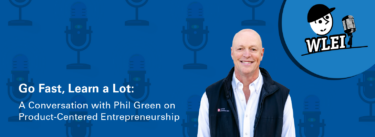Be among the first to get the latest insights from LEI’s Lean Product and Process Development (LPPD) thought leaders and practitioners. This article was delivered to subscribers of The Design Brief, LEI’s newsletter devoted to improving organizations’ innovation capability. It is the third of four in a series focused on craftsmanship or the pursuit of perfection in products and people. Craftsmanship embodies simple elegance, precise execution, and a deep, personal connection to work that transforms both the creation and the creator.
The transformational craftsmanship movement at GE Appliances is as much a revolution in how to think about new product development and manufacturing as it is a revolution in the use of digital technologies.
Traditionally our product design focused on reliability, performance, and quality – and we’re good at them – but craftsmanship opened a whole new way of thinking about developing products that naturally made sense to us. Our products are used in half the homes across the country and play an essential role in how people live on a daily basis.
We define craftsmanship as how customers perceive the quality of products based on all the things they can see, feel, and hear on a retail store showroom floor as well as how they work at home.
It means not just delivering products that work well but ones that consumers love because of how color, finish, and form harmonize; how buttons and controls operate, how drawers and shelves move, or how a range or refrigerator door sounds when it closes.
“Apple-esque” design thinking
Craftsmanship means transitioning away from thinking about appliances as utilitarian tools to thinking about them as experiences. Sure, they perform jobs in the home, but daily interactions with them present continuing opportunities to delight people with not only how well an appliance works or how long it lasts, but how elegant it looks within the home, or how conveniently it updates its software through your home WiFi. It is not just some plain white box that washes your clothes. It is taking the “Apple-esque” way of thinking about design and applying it to appliances.
The current craftsmanship movement began around 2017 when several company efforts converged. The “zero distance” and “cocreation” philosophies emphasized getting closer to consumers and designing products with their input. A “house of brands” strategy gave GE Appliances’ product lines unique identities, so consumers, designers, and builders understood what brands met their needs, lifestyles, tastes, and price points.
Finally, a benchmarking study on how other industries used digital technologies gave the GE Appliances’ team the inspiration and practical knowledge to execute craftsmanship – in product development and manufacturing – digitally and differently.
Digital tool sequence
Three-dimensional scanning, the first digital technology we adapted, opened the door to digital engineering. If you can point a scanner at a part, prototype, or finished product you can digitize it. Coupled with new software, engineers transitioned from working with spreadsheets and in a one-dimensional design space to a data-rich digital environment. Engineers overlay digital scans of physical parts with CAD designs to generate colored “heat” maps of how well – or poorly – the part matches design tolerances. We discover and solve problems in hours or days that would have taken weeks or months.
Virtual reality, the next digital technology we deployed, allows for a much more cost-efficient and seamless process from the industrial design phase to final product engineering. Engineering and manufacturing experts can quickly assess initial industrial design concepts at the beginning to ensure that certain concepts can be executed well. If a design cannot be effectively engineered for manufacturing, it will ultimately lack craftsmanship. Beyond that, involving product managers, industrial designers and manufacturing engineers early and often throughout the process gives everyone a chance to regularly visualize the current design state and apply their expertise to ensure concerns are raised as early as possible.
The company has also successfully used VR to involve consumers in product design. For example, a proposed top load washer design had a very deep tub. Some consumers interacting with the design in the VR lab noted that a sock at the bottom of the tub would be unreachable for some people. Without VR, we would have incurred costs building a prototype to figure that out.
A lot of craftsmanship is attention to detail, and it must go to an obsessive level. VR lets us do that by bringing design teams together in the lab. They examine, among other issues: do joints align; do edge radii enhance appearance, assembly, and fit; what colors look best on range knobs and; is the joint between the range frame and glass top easy to clean; will a highlight on an edge look good to consumers.
We now do a much better job of having debates and discussions around such questions early in the development process.
Next, GE Appliances implemented digital dimensional control technology, a game-changing design philosophy. The program teams learned to recognize and manage variation in product and process design through a “design for dimensional control” approach. With new dimensional simulation software, the design teams can build product virtually to ensure they achieve craftsmanship and quality targets before building any physical products.
They identify any issues with surface quality, gap and flush, critical clearances, and fit. Programs where we have driven rigor in dimensional control and craftsmanship have resulted in exceptionally better products and manufacturing processes. At all build phases, parts fit as they should, even on prototypes. In some past designs, production workers might have had to hold panels in place, move them, or press them to align screw holes. Now we are designing craftsmanship and quality into the process, rather than trying to control it on the back end.
Through dimensional control principles, our engineers recognize that design float, the design clearance between mating features of parts, is enemy number one. The more design float you have, the more variation you will see during assembly. This key insight has driven robust locator solutions. In fact, using product and process locators is one of our most important design strategies going forward.
No Pareto to craftsmanship
Ultimately, the consumer, not technology, is central to craftsmanship. Engineering team members spent hours observing people shopping for appliances. They noted, for instance, that when considering a range, customers stepped back, looked at it, then walked up and grabbed the knobs. Their first physical perception of range quality was how the knobs feel. If they wobbled, the customer frowned and moved to the next product. It was a revelation.
Seemingly small issues – like the feel of knobs – were actually big ones. If knobs are loose or the edges of refrigerator drawers are sharp, customers get a subconscious impression of mediocre quality. They assume that what they cannot see is executed with the same level of quality as what they can see and touch. You can’t Pareto that. You can’t achieve well-crafted products by focusing on the critical few and ignoring the trivial many. You must pay attention to all the details.
The engineering team also pores over online customer product reviews to gain insights into consumer preferences. For example, in a major redesign of GE Appliances’ slide in and freestanding ranges, the team learned that consumers often noted that the sound of the timer on current models was too soft to hear in a busy kitchen or from an adjacent dining room, so we made it louder. Traditional quality focuses on meeting engineering specifications, so it misses areas where design doesn’t meet consumers’ needs. By taking the time to listen to feedback, we can address these pain points as we design new products.
People sequence
Bringing people on board for change is a critical element in implementing new technology at an organization. At GE Appliances, support for these new tools started with CEO Kevin Nolan. Investing in tools and equipment is key, but you also must invest in people. We got the authority to hire people who had digital technology and dimensional control experience to build a critical mass of people with the needed skill sets.
We also trained many other people in subjects such as dimensional control and 3D tolerance analysis. But training alone was not decisive in adopting digital technology with a craftsmanship mentality.
Hands-on experience is key to success. For the redesign of a major platform, we put together teams that included a mix of experienced dimensional control engineers to work side-by-side with colleagues who were new to these tools. Lessons from training classes don’t sink in until you are faced with the challenges of how to fit two parts together or how to control the flushness of a joint. You work through it with someone with expertise who coaches you through this new design approach.
Finally, if a business wants to create a meaningful and lasting transformation, whether it’s craftsmanship, digital technology, dimensional control – you name it – it must have a small set of people who eat, sleep, and breathe the transformation daily. They are passionate about it. They generate the continued momentum to keep pushing, pushing, and pushing the transformation because they show up every day expecting a certain level of excellence. They get people to look at products the way customers see them and be passionate about them too. They get people to think, “I’m only doing the hinges, but I’m going to do them better than anybody else.”
That way of thinking about craftsmanship coupled with digital technologies has fundamentally redefined how we design products. It has led to a tremendous amount of innovation, which has fundamentally changed our company for the better.
Designing the Future
An Introduction to Lean Product and Process Development.






